Nitrous oxide: A potent, long-lived, and rapidly increasing greenhouse gas
A relatively unknown greenhouse gas plays an important role in climate and ozone depletion, and its importance will continue to increase to meet the growing demand for food, fibre, and energy.
Nitrous oxide (N2O) is a greenhouse gas 300 times more potent than carbon dioxide over a 100-year time horizon, and it remains in the atmosphere for well over 100 years. It rarely gets a mention, with most focus being on carbon dioxide, methane, and even cooling aerosols like sulphur dioxide.
But nitrous oxide packs a punch, not only is it the third most important greenhouse causing climate change, but during the 21st century it will be the main substance destroying the ozone layer.
For these reasons, together with 57 leading researchers around the world, we have published the most comprehensive analysis of the sources and sink of nitrous oxide in the journal Nature.
Concentrations of nitrous oxide in the atmosphere have remained stabled for thousands of years, but have shot up in the last 200 years, and the trend does not look like reversing anytime soon.
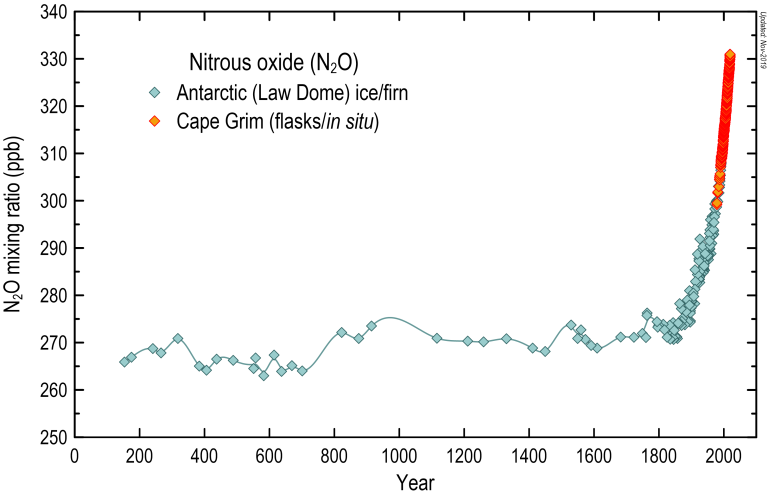
The growth in atmospheric concentrations means that nitrous oxide accounts now accounts for about 7% of the current net radiative forcing of the climate system, which is driving the current increase in global average temperatures. This sounds small, but the number is expected to increase over time.
Of all the species causing radiative forcing (and temperature change), nitrous oxide is the only component that increases in aggressive mitigation scenarios. Even if the world can keep global warming below 1.5°C above preindustrial levels, radiative forcing from nitrous oxide is set to rise around 50% over the 21st century, due to historical emissions, and its long lifetime and difficulty to mitigate.

Where does nitrous oxide come from?
Nitrous oxide comes almost equally from natural (60%) and anthropogenic (i.e. human-driven) sources (40%).
The natural sources are dominated by microbial processes that break down nitrogen-containing compounds in the soil and oceans. In the past, these natural sources were balanced by nitrous oxide destruction (by powerful solar radiation) in the upper atmosphere, meaning the atmospheric nitrous oxide concentration remained constant for thousands of years.
The anthropogenic sources are dominated by agricultural activities, but also include emissions from fossil fuel combustion, industry, wastewater, and biomass burning. It is these anthropogenic sources that are driving the increase in global N2O concentrations.
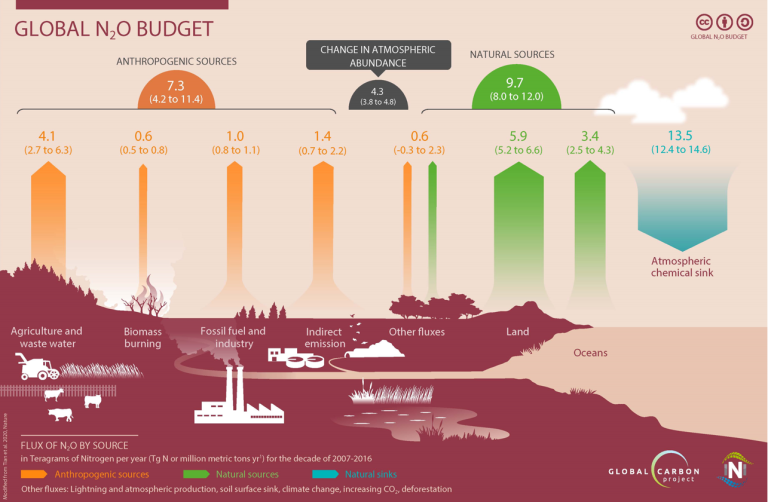
Why is agriculture so important?
The largest direct anthropogenic source of nitrous oxide emissions is the agricultural industry, contributing to over half of the emissions and growing at 1.4% per year. About two thirds of these emissions come from the use of synthetic fertilisers.
Excess fertiliser makes great food for soil bacteria, enhancing the microbial processes that lead to nitrous oxide emissions. The remaining one-third comes from manure, again, with microbial processes leading to emissions. These are the same microbial processes that lead to natural nitrous oxide emissions.
Fertiliser use and manure also lead to nitrous oxide emissions remote from agricultural land, as excess nitrogen (as nitrates and ammonia) may be transported to other places through water runoff and atmospheric dispersion, leading to further nitrous oxide emissions.
In addition, atmospheric transport of nitrogen compounds released by human activities also provide ecosystems with excess nitrogen, leading to additional nitrous oxide emissions. These indirect emissions constitute around 15% of the anthropogenic total and are growing at around 1% per year.
Other direct nitrous oxide emissions include fossil fuel combustion, industrial production of fertilisers and synthetic materials (especially nylon), wastewater, and biomass burning. These direct sources make up around 25% of the total and are growing at 0.9% per year.
New to this study, is the inclusion of the perturbation to nitrous oxide fluxes from climate, increasing atmospheric CO2, and land cover change. Some of these processes vary considerably from year to year, but all are becoming increasingly important and represent a positive climate feedback on nitrous oxide.
In the last decade, the increase in nitrous oxide emissions is dominated by direct agricultural sources, but the changes in the perturbed fluxes are becoming increasingly important.
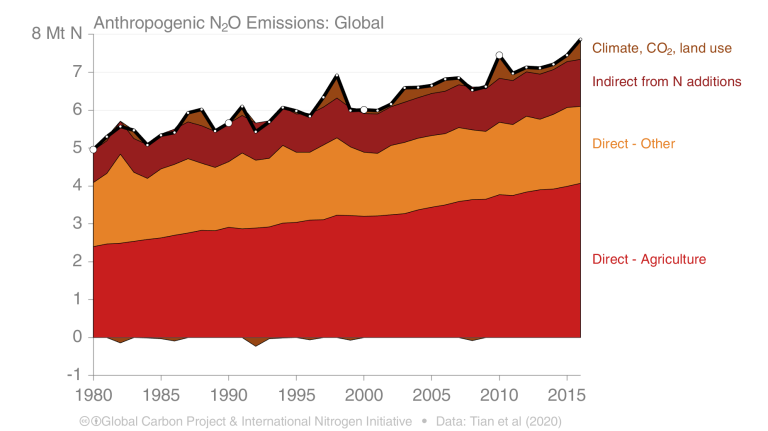
Regional distribution
Over the last four decades, nitrous oxide emissions are growing fastest in Asia, Africa, and South America. The emissions growth in these regions is dominated by agriculture.
The EU stands out for showing a decline in N2O emissions. This is because of successful voluntary and policy-driven emission reductions from industry, and a slight decline from agriculture despite increasing harvest yields.
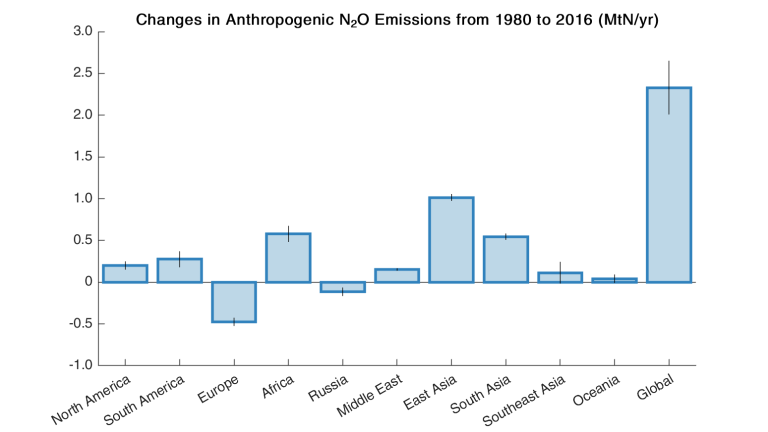
Per person, the biggest emitters remain the rich regions, North America, and Europe. Russia has highly variable emissions from industry, while South America has seen strong growth from agriculture.
A share of this agricultural production is for export, but this was not considered in the analysis. If these results were adjusted for international trade, it would be expected that the rich countries would have higher emissions due to food imports.
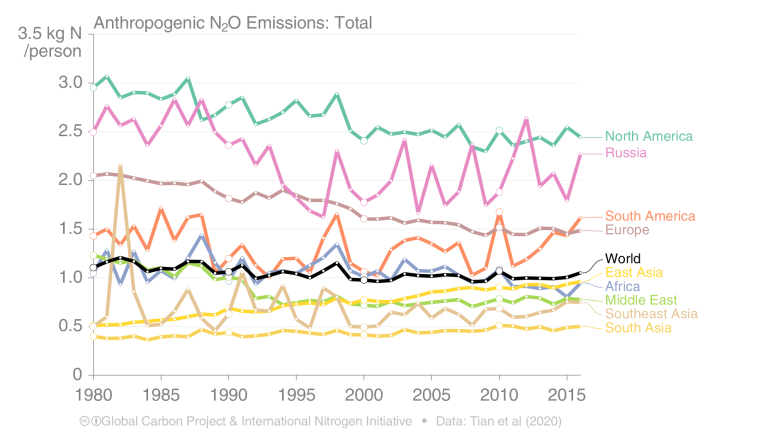
Worrying trends
The continued growth of nitrous oxide emissions in the recent decades is likely to continue with a growing population and increased demand for food. These trends are clear in the historical data.
Compared to scenarios, corresponding to different levels of global warming, the historical trends are consistent with low levels of mitigation and, thereby, higher future warming levels.
Because of the challenges in reducing nitrous oxide emissions, even strong mitigation scenarios, consistent with the Paris Agreement, lead to only modest reductions in nitrous oxide emissions in this century (SSP1-1.9 and SSP1-2.6).
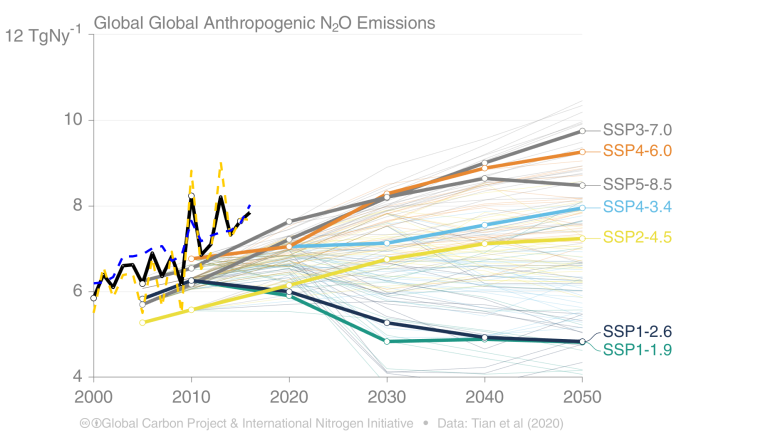
Even bringing nitrous oxide emissions under control, atmospheric nitrous oxide will continue to rise throughout the 21st century because of the long lifetime of nitrous oxide in the atmosphere.
Because of its long lifetime, nitrous oxide behaves more like carbon dioxide than some other greenhouse gases (particularly methane). A failure to reduce nitrous oxide emissions means more reductions in CO2 emissions are needed, otherwise higher warming levels will be reached and climate change more severe.
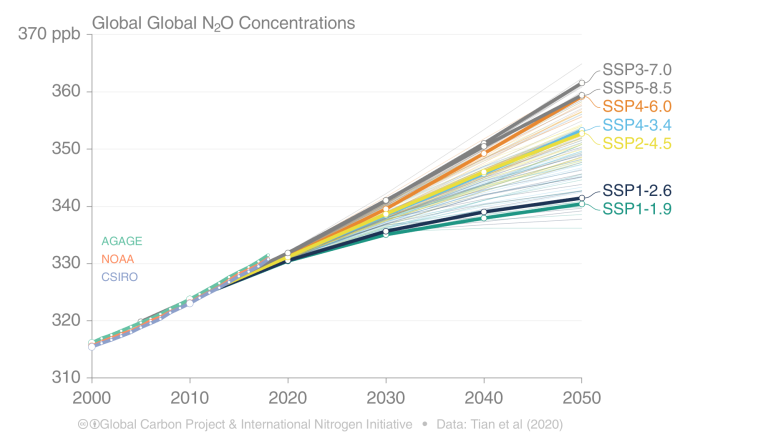
Changing path
Carbon dioxide emissions in recent years have shown indications of a slowdown in growth. However, this is not the case, where nitrous oxide emissions continue to grow unabated.
While current trends do not paint a rosy picture, there are clear examples of how these trends can be changed. The EU stands out as a strong example where nitrous oxide emissions were reduced. In the US, nitrous oxide emissions have also remained relatively stable despite growing agricultural output.
The EU was able to reduce emissions through both voluntary actions and policy. Industry has successfully been able to reduce emissions, and policy has encouraged more efficient use of fertiliser in agriculture. This has happened in parallel to increased production. Applying similar measures in other countries could quickly shift nitrous oxide emissions onto a more sustainable pathway.
As is often the case with climate mitigation, there are clear win-wins with other environmental problems. Cleaning up nitrous oxide also cleans up water pollution and helps to keep the ozone layer in place.
Read the paper
The study was led by Professor Tian and involved an international consortium of scientists from 48 research institutions in 14 countries under the umbrella of the Global Carbon Project and the International Nitrogen Initiative.
The goal of the effort was to produce the most comprehensive assessment to date of all sources and sinks of the potent greenhouse gas, nitrous oxide (N2O). Find the paper at Nature, also for free, and access all the materials (data, figures, presentations).